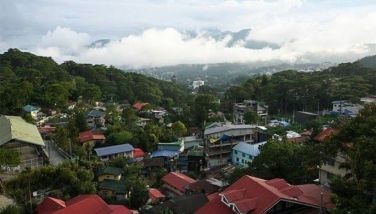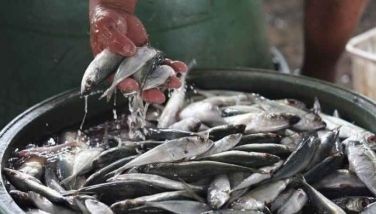Unsung heroine of the Death March
After the Fall of Bataan, the infamous "March of Death" began at daylight on April 10, 1942, in Mariveles, Bataan.
Extremely weakened from hunger, disease, thirst, and fatigue, the more than 70,000 Filipino and Ame-rican soldiers taken prisoner by the Japanese were forced to march 55 miles to San Fernando, Pampanga, then taken by train to Capas, Tarlac, where they walked the final eight miles to Camp O'Donnell in Arenguren in Capas.
Those who fell were bayoneted by the Japanese enemies. Only 54,000 reached Camp O'Donnell. Approximately 10,000 Filipinos and 1,200 Americans died on the road and the rest escaped into the jungle.
American defender Ted Williams, a former United States Marine of the 3rd Battalion, Fourth Regiment, survived incarceration at Camp O'Donnell and wrote me to find this unknown heroine of World War II in Tarlac. His letter dated May 1, 1997 read:
Dear Madam Governor,
"On April 9th, accompanied by my youngest granddaughter, Mrs. Amy Lynn Schaar, I made, my 16th sentimental return to Capas.
...Camp O'Donnell shall forever be remembered as a bastion of death and inhumanity. The same should never be denigrated nor the memory defiled, for this hallowed ground exemplifies the tenacity of mankind. The memory of Camp O'Donnell haunts me constantly and burdens sleep with unspeakable horrors of humanity at its worst.
While at Capas Shrine, I retold the enclosed story to Amy who felt that it should be brought to your attention. In this new world of women in the forefront, it is my duty to preserve credit for the deserving. Too long, man has usurped total responsibility, denigrating or ignoring responsible and accomplished distaff partners. Too long this episode has remained locked in my memory.
To that end, I send the enclosed story in the hope that you will enhance the local shrine with a plaque or memorial to a true heroine. In closing, please accept my sincerest thanks, for your province's hospitality, from my granddaughter and me.
This is his story:
This humble correspondent is a 76-year old survivor of the Bataan Death March and Camp O'Donnell incarceration who recently returned to Capas for the Araw ng Kagitingan ceremonies and National Shrine dedication. The event brought me full circle, back to possibly one of the most significant chapters of my life. This memorable scenario is depicted below and exemplifies the compliant resistance and valiant heroism of the Filipina/o.
After survivors of that dastardly trek reached San Fernando, we were literally crammed into diminutive box cars and "shipped" to Capas, Tarlac. Upon detraining, we were pummeled into semblance of military order and marched to a fenced school yard on the North Eastern perimeter of the barrio. On the veranda of the small schoolhouse, a short, stocky Japanese captain paced impatiently, eager to impart this message of strict compliance to the rules of our new masters. Ours was one of the first contingencies and numbered about four hundred.
Into the yard, full of bewildered prisoners, strode a small sophisticated Filipina, leading a number of school girls laden with baskets of prepared morsels. When she directed her charges to disperse and distribute their wares, she was seized by two guards and half dragged to the raging officer. Screaming epithets and incriminations, Hirohito's messenger began slapping the woman's face. When he relented for a moment, she turned to her helpers and directed them to pass out the food. Furious, the red-faced captain again assaulted her and threw a staggering blow to her midriff. This sent her sprawling onto the wooden floor, retching from the blow. At this point the officer kicked the courageous woman and ordered her to her feet. She arose, summoned superhuman poise and stared defiantly at her tormentor. Through bleeding lips, eyes ablaze, she again beckoned to distribute the goods. Once more she was pummeled to the ground. Again this angel of mercy regained a standing position and summoned to the basket bearers. At last the Captain shook his head in despair and allowed the food to be distributed.
To this very day the chagrin of her heroic stand haunts me. Where was the US Marine pledged to defending the Philippines? Where was the courage displayed by this wonderful woman risking her life to provide a morsel of decency in an insane world? What quest for survival overshadowed valor?
If there was truly a hero (heroine) in the maelstrom of human indignity, barbaric savagery and death, it was that unnamed lady.
A concerted effort should be made to name and immortalize her forever. The city of Capas and Province of Tarlac can be ever proud of her example. I know I have spent fifty-five years in awe of this woman's intrepidity.
Women's stoic support and deeds lie too long unnoticed in the annals of history. Let us recognize that "the hand that rocks the cradle" also "lays her life on the line for her sons, brothers and husbands." The same strength which brings us life also enforces and dignifies its significance.
Ted R. William
603 Grove Ave. Anaheim, Calif. 92805, USA
For six years, Tarlac celebrated the culmination of the Death March on the exact location where World War martyrs survived or died. It was a noble gesture to construct a memorial site spearheaded by General Renato de Villa. However, thirty squatters deterred its timetable for construction. One late evening, I decided to see the lady who owned the concrete house in the far end of these 50 hectares to listen to her plea. Would it be a strict adherence to my duty or compassion on my part?
Entering her 100 square meter abode, cavans of rice reached the ceiling from where scrubbed pots and pans hung. She was 77 years old, extremely alert and respectful. I asked, what should merit her stay on the grounds, insistent as she was. Her answer was:
"I dressed up the survivors after the Japanese buried the POW's. I heard the moans of the dying and those alive who were being buried under the earth with the dead."
Felicisima Sebastian, was a laundry woman charging the Japanese Army personnel 10 centavos per long pants, 5 centavos for short pants and polo shirts for washing. She added:
"Those POW's who were still alive rose from their graves. I and my neighbors helped them and I hid the POW's in my house. I nursed them back to health, dressed them up with clothes from dead POW's and from the clothes of the Japanese military officers that I had washed".
Maybe Aling Piling is not the woman Mr. Williams alludes to. We may never know whom Ted Williams speaks of for history will never repeat itself in exactly the same circumstances. But women can learn from the experience of "her sister's" courage, kindness and determination.
Let us say a prayer for all the Filipino POW's who fought with the American Prisoners-Of-War for our country and one in praise of womanhood. Indeed women, unlike men or like some males, can be made of sterner stuff.
- Latest
- Trending





























